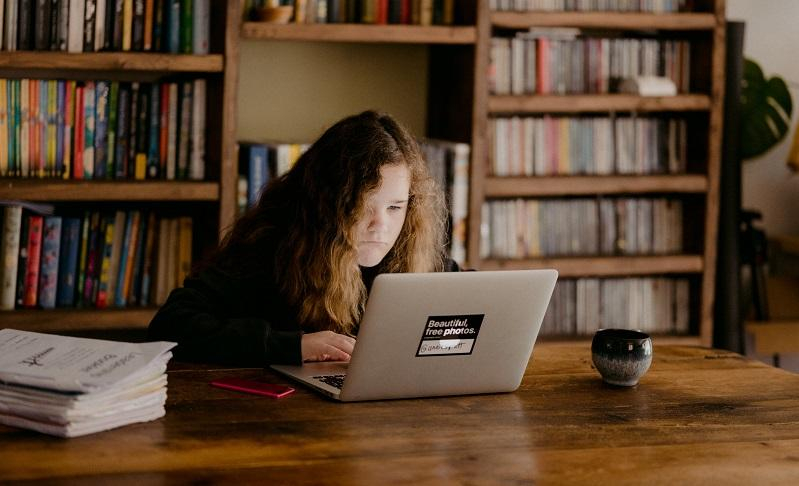COVID-19 School Closures and Home Schooling – What's Your Game Plan?
Current Events
|
Mar 24, 2020
|
9 MIN READ

By Deena Majeed
In the last two weeks, nearly 70 percent of schools in the U.S. have shut down and sent millions of children home, some for the entire school year. This means that millions of parents have been thrown into supervising remote learning and/or schooling from home, or homeschooling.
This has complicated things for mothers who work from home (WFH) or who now have to stay home and help their children with school work. Even stay-at-home moms who have never home schooled before are facing challenges.
If you’re a mother whose kids are now schooling from home, your regular, structured routine is now out of whack. It may feel like a free for all or some type of a Lord of the Flies situation. Or, maybe you are trying to operate a schedule and are finding yourself having tense standoffs with your kids or begging them to complete their work.

Photo by Annie Spratt on Unsplash
Whatever the situation, as a parent you’re having to balance all the stress on your shoulders that comes with worrying over this coronavirus pandemic, and at the same time you’re taking care of one, two, three or more other human beings. There is still lunch to be made, laundry to be washed and things to get done (not to mention your office work, if you are WFH).
Some schools have chosen to implement remote learning through online courses while others are sending students home with work packets and assignments to complete. As a homeschooling mother (I have three kids ages seven, five, and one), I know that it’s no small feat to do this.
In the beginning (I would say for my whole first year of doing it), I was wading around in a pool full of curricula, printables and resources. I was throwing stuff at the wall and waiting to see what stuck. So, I feel you mammas out there, and I know you can do this.
Not sure where to start or what to do? Here are some tips to get you started and get you through the rest of the school year. You got this!
Take a Breath
Do you feel like a log drifting down the river and being pushed every which way? You’re not sure what direction to take. First piece of advice is to take a breath. Take a real, deep, meaningful breath. Deep breathing can help slow your heartbeat and possibly help your blood pressure stabilize and reduce stress levels.
We’re stressed by many things right now: the possibility of any of our loved ones getting sick or catching the coronavirus, by whatever financial hardships we may be facing., that our masajid (most of them) are closed or closing. And now, we’re stressed because the upheaval in our kids’ education and that they are getting restless and bored.
When you wake up every morning, take a few seconds to catch your breath and give yourself a break. You’re already doing enough. Remember that this difficult situation will pass.
Don’t Stick to a Strict Schedule
Do a schedule, don’t do a schedule, be strict, let the kids run free – it’s a tough thing to figure out. What I know is that forcing your kids to wake early and finish all their work at once will result in cranky, unhappy, bored children. Remember, they’re at home now. Take advantage. Wake up, enjoy breakfast with the kids. Take 15 minutes to savor your coffee. Write down what you plan to accomplish today for yourself, and write down what you want to accomplish for your kids in regards to schooling.
Set goals for your children, and tell them that you want them to complete their goals throughout the day. You can break up their subjects throughout the day with breaks/snacks/playtime in between so that the day is not monotonous. Make your schedule flexible and prepare not to get everything you planned done in one day. That way you’re not disappointed or on edge by the time Maghreb rolls around, and you realize not everything was done as planned.
Remember, this may be a stressful time for the kids as well. Kids often mirror our emotions and stress levels. If they see that we’re freaking out, they might begin to feel stressed as well.
Younger kids will need help with their work. For older kids, you may need to set firm limits, such as no video games until they complete their work. Or, you can compromise and allow them video game breaks in between each subject. And remember, what may be your schedule on one day may need to adjust to something else the next day.

Learning Can be Anything
Repeat after me: Learning can be anything! Does your child refuse to do their math worksheets? Maybe they’re boring or difficult, or maybe they don’t know how to get through it. Consider breaking out the measuring cups and baking supplies and use baking to demonstrate division or fractions.
If your child is struggling with multiplication, use jelly beans and divide them into groups and have your child count out each jelly bean in each group. If you want a less sugary option, you can always use cereal pieces. Then after you complete the activity, you can go back to the worksheets and apply what your student learned.
Learning can be the way your kids help you cook and measure out ingredients. It can be in a nature exploration in your backyard as you spot different birds and try to figure out their names. It can be in sorting and organizing laundry for the little ones as they count the number of socks and pairs of socks they have.
Learning is not only through worksheets and elaborate lesson plans. It can be through your everyday life. It can be found in your children’s interests. Maybe your son loves to take pictures with your phone. You can have the pictures printed and shipped to your home, and he can make a photo collage.
Focus on One Subject at a Time
You just woke up; the house is in chaos. The kids are already fighting over the electronics. Where do you start? To keep your sanity, focus on one subject at a time. Start with what your children are interested in. If it’s raining outside, and your first grader is asking how rainbows are made, you can do a lesson on rainbows. You can alter the lesson and activities based on each of your children.
Your preschooler can color a picture of a rainbow. Your second grader can learn about light particles and how they separate to make a rainbow. All of you together can do an experiment to make a rainbow using sunlight and water. By focusing on one thing at a time, you’ll feel more grounded.
I know that many students have assigned remote learning work to complete, so it may not be realistic to add more assignments to your daily workload. Instead, you can choose to do one fun project a week to supplement their lessons.
For those parents feeling overwhelmed by their child’s weekly remote learning schedule, you can keep track of your child’s deadlines – whether daily or weekly – with a planner. And I don’t mean the planner on your smartphone. I’m talking about a physical, old-school planner where you can write each student’s work, deadlines and projects to complete. This can help you see what you need to complete every day.
Alternatively, you can get a regular notebook and write out a list of tasks you want to complete each day for each child. This way, you can go through each task or subject one at a time. By writing everything out and crossing completed tasks off your list, it can help you feel accomplished and productive as you go through your day.
Set Aside Quiet Reading Time
Set aside a special time during the day where everyone grabs a book and reads. If you have older kids, they can pick a book of their own and read to themselves. If you have younger kids, you can read aloud to them. Start this out for a short time, maybe 15 minutes a day, and build the habit. During this time, no electronics or distractions. You should also choose a book to read. If nothing else gets done during the day, you’ll feel assured knowing that you can at least implement this habit.
Use Screen Time (In an Educational Way)
Like it or not, screens are a major part of our lives. These days we find ourselves glued to our smartphones as we’re checking the news for any coronavirus updates. We’re checking our messages to see what our loved ones are up to. Why don’t we use screen time to our advantage?
There are countless resources that can be used as homeschooling tools. Here are some ideas of screen time you and your kids can do together:
1. Tour a Museum: Always wanted to see some artwork from the British Museum in London or the Musee d’Orsay in Paris? Many museums are offering virtual tours of some of their exhibits and artwork. You can view a list at Travel & Leisure.
2, Explore the World: You can take a field trip from home and explore different parts of the world through Google Earth.
3. Watch a Documentary: Most of the major streaming platforms offer countless documentaries and educational shows where your children can have their screen time and learn at the same time. You can choose a documentary that supplements what they’re already learning.
4. Educational Websites and Apps: Many companies are offering free trials or access to their websites and apps during school closures such as BrainPop, ABC Mouse, Khan Academy, Prodigy, or Mystery Science are just to name a few.

Image source: ThyBlackMan
Homeschooling Based on Grade Level
Maybe you have one child in second grade and a high schooler. Or maybe you have three kids all in elementary school. Your style of teaching and their style of learning might be different for each student. Here are some tips based on each age group.
Preschool/Kindergarten: For children this age, the best type of learning is play. Play helps kids “use their creativity while developing their imagination, dexterity, and physical, cognitive and emotional strength.” The best way to encourage this is to give kids simple items for play. For example, crayons, scrap paper, modelling clay, paint, finger paint, blocks, colored pencils, sand.
Let them make music with your wooden spoons. Allow them to play with your plastic container sets. If you have a backyard and the weather is nice, give them sidewalk chalk and bubbles and allow them to play. Play hide and go seek in the house. Play tag outside. Let them make up a game and tell you the “rules” of their games.
I know, sometimes it can be boring to play with kids all day long. You can compromise with them. Tell them you will play one game with them or one activity, and then they will have to play together while you make dinner or complete your own work.
Elementary School: At this age, kids can start to do independent work with your help. Before they work on their lessons/worksheets, go over it with them and see if they have any questions. Do a quick review or lesson to refresh everything in their minds. There are also plenty of subscription boxes where your kids can work on projects and themes independently. Your children will still need plenty of breaks/play time, but they’re also old enough to entertain themselves.
Middle School/High School: At this point, your kids should be able to do most of their work independently, however, that doesn’t mean you can’t learn with them. At this age, you can help get your kids started on complex projects and serve as a guide for them along the way.
Talk to your older kids and see what they’re interested in, what they want to work on, and ask them how you can help. If they’re studying biology, you can help them gather candy supplies to build a DNA model or a heart model with household supplies. If they’re learning about ancient Rome, watch a documentary or a video with them, and ask them questions to get them thinking.
What if your teen is uninterested in their assignments or doesn’t talk much about their school work? Perhaps they’re feeling uninspired and unmotivated. Maybe they’re having trouble or not understanding the work. Maybe they feel like why do the work if it won't be graded (if that's what is happening in your school district.). You can reach out to their teachers and see what your child has been working on in school. Suggest focusing on one subject a day, if that helps.
There are also plenty of online tutoring services if your teen is struggling with a subject. Check with your child's teacher, school and school district. Chances are they may be offering certain time slots during the week for extra help or to ask questions.
There are so many resources and advice out there, and it’s easy to become overwhelmed. My advice is to play around until you find what (more or less) works for you and stick with it. From there, you can gain inspiration and see what works and what doesn’t work for your home. Every home is different, and everyone’s situation is different, so what works for you may not work for someone else.
I’m sending you all my love, du’as, and best wishes.
Deena is a writer and homeschooling mother based out of Northern California. When not homeschooling her children, she loves giving book recommendations, hosting tea parties and trying new recipes. Find her on Instagram @deenamaj!
Subscribe to be the first to know about new product releases, styling ideas and more.
What products are you interested in?

